The mystery of dark matter
Matter as we know it—atoms, stars, planets, trees, rocks and us—account for less than 5% of the known universe. The rest remains somewhat of a mystery. A dark one.
Astronomers and cosmologists think around 25 per cent of our universe is made of something called dark matter, and the remainder—around 70 per cent—is what’s known as dark energy. Dark matter doesn’t interact with light, so we can’t see it. The only reason we know there’s something out there beyond what we can directly see is because it interacts with gravity.
Essentially, the gravity exerted by the visible mass of galaxies and clusters is insufficient to hold them together—there’s got to be some additional mass there to create the extra gravity needed. Without dark matter, stars would likely be scattered all throughout the universe. Galaxies, including our Milky Way, and therefore us, would not exist.
The work of many astronomers contributed to our current understanding of dark matter. In 1933, the astronomer Fritz Zwicky observed that galaxies within the Coma cluster were moving faster than expected; speeds which should have caused them to leave the cluster rather than being held in by its gravitational pull. Some years later, Australian astronomer Ken Freeman noticed gas was moving around galaxies at greater and greater distances at the same speed, despite there being little material at these large distances. Vera Rubin saw the same thing with stars on the edges of many galaxies.

These observations indicated that the gravitational fields in the galaxies were greater than expected based on their amount of visible mass—the large gravitational pull they were exerting could only be explained by the presence of some sort of additional mass. The best guess as to where this mass comes from is that it’s some sort of strange exotic particle: dark matter.
No one knows much about this particle, except to be pretty sure it’s something we’ve never encountered here on Earth. It doesn’t interact with light, hence the name ‘dark’ matter, which means that it’s neutral, with no electrical charge. It's also slow moving, being concentrated in galaxies and clusters rather than dispersed evenly throughout space.
Even though we don't know what it is and we can't see it, we do know that dark matter matters.





